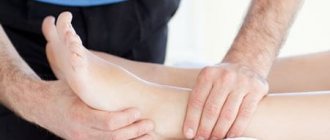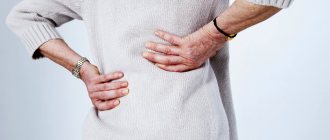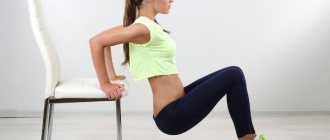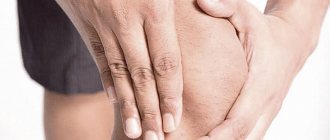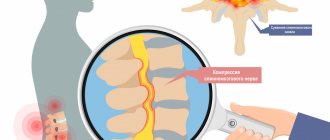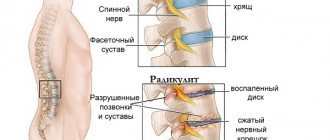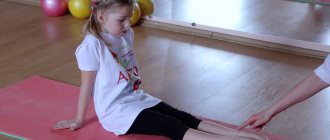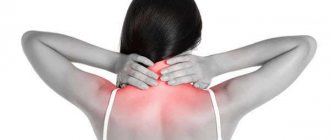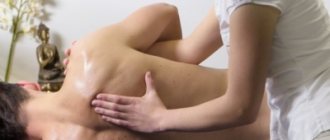There are many factors that lead to the emergence and development of a disease such as radiculitis. It is diagnosed in most office workers, as well as in those who lead a sedentary and sedentary lifestyle. The disease may bother you constantly or periodically, but in any case, this issue must be resolved by contacting a neurologist
. Radiculitis, like any disease, is treated comprehensively: taking medications, blockade with anesthetics, various methods of physiotherapy and physical therapy. Therapeutic massage for radiculitis is considered one of the effective and most useful methods in the absence of contraindications. Massage is prescribed and used to improve blood flow, relieve muscle tension and normalize muscle tone, as well as improve metabolism. In addition, massage is an excellent anti-stress therapy for radiculitis and more. However, for the treatment of radiculitis, massage is prescribed only if the patient is diagnosed with a subacute or chronic form. In acute forms of the disease, massage is contraindicated.
What is sciatica
The prevailing opinion that radiculitis is a separate disease is not entirely true. By radiculopathy, official medicine means a set of symptoms resulting from inflammatory or deforming processes in the nerve fibers extending from the spinal cord through the intervertebral foramina.
When inflammation and deformation occur in the nerve fibers of the spine, a characteristic pain occurs, which is known as sciatica
The most commonly observed clinical picture of radiculitis: acute intense pain, which can appear suddenly when performing habitual physical activities and movements or during a period of rest after some time.
Pain syndrome can manifest itself both directly at the lesion and spread to areas innervated by the affected spinal root.
Here, in parallel with pain, symptoms such as:
- sensory disturbances (numbness, paresthesia);
- decreased motor reflexes;
- deterioration of muscle tone.
Quite often, the patient is forced to take a position that somewhat alleviates physical suffering: for example, sitting with a bent leg or tilting his head like acute torticollis.
In addition to degenerative changes in the spine, the etiological factors of radiculitis may include:
- acute infectious diseases;
- injuries;
- excessive physical activity;
- radicular manifestations of neuroviral diseases;
- hypothermia.
In the absence of therapy, decreased quality of life and loss of performance are not the most serious consequences of radiculopathy. The main danger is that the diseases that caused the development of radiculitis are not treated - spinal stenosis, intervertebral hernia, osteochondrosis. The long-term prognosis for the outcome of such a situation is dysfunction of the pelvic organs, spinal cord infarction, paralysis of the limbs, and disability.
Symptoms
Irritation of the nerve root causes various pain sensations, varying in nature and strength. Pain is divided into:
- aching;
- stupid;
- cutting;
- drilling;
- pressing;
- shooting;
- roaring.
The pain is exhausting and prevents you from living and sleeping fully. Sometimes the severity of the pain is similar to the pain that occurs when you shoot in the lower back. 70% of patients experience acute pain. In the remaining third of cases, the onset is subacute, appearing a few days after exposure to irritating factors. At this time, there is a gradual increase in swelling of the soft tissues near the spine. Some patients describe the onset of the disease in the morning, immediately after waking up, or while getting out of bed. Suddenly there is a sharp pain sensation. They intensify even with minor movements while turning, walking, or sneezing.
The patient takes a forced position in bed, lying, as a rule, on his healthy side, trying to pull his bent leg as close to his stomach as possible and clasp it with his hands. If the pain has spread to both legs at the same time, then patients, in most cases, take a supine position and bend both legs at the knees. This is called the pillow sign. The pain does not allow a person to lie on his stomach, and being in an upright position, the patient bends on one, usually healthy side. Also typical is the “tripod” symptom, when a person rests in a sitting position on the seat of a chair, or on his knees. This way the lower back is unloaded. Among the signs of the disease:
- Changed gait, constrained, uncertain movements.
- Involuntary flexion of the knee joints.
- Reduced sensitivity in the area of inflammation.
- Tingling, burning sensation in the soft tissue area near the lesion.
- Weakened muscle fibers.
- The appearance of dizziness.
- Increased pain at night.
- Deterioration of vision.
- Malfunctions in the gastrointestinal tract, genitourinary and cardiovascular systems.
What are the main methods of treating radiculitis?
The choice of treatment tactics depends on the severity of the pain syndrome, its duration, and the nature of changes in motor skills.
Surgical intervention is only advisable if :
- the patient experiences intense pain for 8 weeks or more;
- there are symptoms indicating concomitant compression of the spinal cord;
- Conservative therapy was unsuccessful.
Therefore, first of all, they talk about the need for complex conservative treatment of radiculitis , which includes the following methods.
The use of medications allows you to quickly relieve pain due to inflammation of the spinal roots. Drug treatment aimed at:
- the fastest possible relief of pain;
- reduction of inflammatory phenomena;
- restoration of circulatory disorders;
- muscle relaxation at the site of pathology;
- eliminating compression of the nerve roots.
For this purpose, analgesic and anti-inflammatory drugs of the following groups are prescribed : NSAIDs; antiplatelet agents; antibacterial agents with a wide spectrum of action; neuroprotectors; antispasmodic drugs.
The purpose of physiotherapeutic procedures , which form the basis of conservative treatment, is to eliminate tissue swelling, stimulate blood circulation, improve the innervation of the spinal cord canals and the metabolic processes occurring in it, and enhance regenerative processes.
These activities include:
- massage;
- exercise therapy;
- balneological procedures (mud applications, radon baths);
- galvanotherapy;
- laser therapy;
- reflexology;
- phonophoresis.
In the vast majority of cases, conservative treatment of radiculopathies provides effective results that reduce pain and stabilize the patient’s condition..
Contraindications
Massage for a hernia cannot be done in the acute stage. Also contraindications for this procedure are:
- acute pain with a hernia;
- acute heart failure;
- skin diseases, open wounds, scratches in the massage area;
- infectious or inflammatory diseases, incl. flu, colds;
- heat;
- high blood pressure;
- blood diseases;
- osteomyelitis, bone tuberculosis;
- thrombosis;
- oncology;
- period;
- other serious pathologies.
We use non-surgical hernia treatment techniques
Read more about our unique technique
The use of massage for radiculitis
For the treatment and prevention of radiculitis, therapeutic massage has become widespread as part of conservative therapy.
How massage can help with sciatica
The beneficial effects of massage on the body during manifestations of radiculopathy are due to the energy-tropic properties of the procedure, aimed primarily at optimizing the functions of the neuromuscular system . As a result:
- metabolism in muscle tissue improves;
- the formation of acetylcholine, a biologically active chemical substance that carries out neuromuscular transmission, increases;
- the transmission of nervous excitation to muscle fibers is accelerated;
- stimulates the synthesis of histamine, an organic compound that dilates muscle blood vessels;
- By increasing the temperature of the tissues of the massaged area, enzymatic processes in muscle tissues are accelerated.
When performing a massage, the following phenomena occur in the body::
- receptors are activated in segments of the spinal cord, which reflexively affects the affected root;
- blood flow to the heart increases;
- biologically active substances are released and neurohumoral processes are activated due to stimulation of mast cells of the subcutaneous tissue;
- single muscle contractions decrease;
- the overall strength of the muscle group increases.
These processes together contribute to the formation of a strong frame for the spinal column from its own muscles, which reduces pain and ensures mobility of the spine.
Video: “Manual therapy for radiculitis”
At what stages can massage be done?
In the acute course of radiculitis, the main symptoms of root compression are its swelling and inflammation, severe pain. Massage movements that stimulate the flow of fluid to the site of pathology aggravate the clinical picture.
Therefore, the procedure is not performed in the acute stage of radiculopathy. For therapeutic massage, the most optimal periods during the course of the disease are its subacute and chronic phases, as well as the remission stage.
Read articles about treating radiculitis at home:
- Radiculitis and sauna: is it possible to warm the spine?
- How and which anti-radiculitis belt to choose? More details on the page
- Names of warming ointments for radiculitis here
Contraindications to the use of massage for radiculitis
Like any therapeutic measure, massage has contraindications and limitations.
The acute stage of radiculitis is a contraindication to any type of massage. It is prohibited to carry out the procedure if the patient has:
- acute stage of radiculitis;
- alcohol or drug intoxication;
- open form of tuberculosis;
- fungal diseases of the skin and nails;
- liver and kidney dysfunction;
- diseases of infectious viral etiology;
- nervous and mental disorders;
- neoplasms, both benign and malignant.
Massage procedures are prescribed with caution to pregnant women, as well as to persons suffering from cardiovascular diseases, hyper- and hypotension, hypocoagulability (reduced blood clotting). For patients from these groups, special or gentle massage techniques are selected, based on individual indicators of their well-being at the time of the course.
Video: “Massage treatment for back pain with radiculitis”
Causes
Among the main causes of lumbar radiculitis:
- the patient has hereditary diseases;
- sedentary lifestyle;
- excessive stress on the spine;
- pathological deformation of joints and bones;
- constant stress;
- pathologies of internal organs;
- hormonal disbalance;
- metabolic disease;
- weakened muscle corset;
- poor diet with excess salt.
Types of massage and technique for radiculitis
Did you know that...
Next fact
There are several massage methods used in the treatment of radiculitis.
| Segmental-reflex | is aimed at eliminating reflex changes in tissues caused by a pathological process. |
| Periosteal | exerts an effect on certain points located near the course of the nerve trunks in order to irritate the interoreceptors of the periosteum. |
| Spot | It is based on the stimulation of so-called biologically active points (BAP) in order to relax muscles experiencing hypertonicity. |
| Canning | also affecting BAP, but due to the creation of a vacuum by medical banks. Vacuum massage allows you to activate peripheral blood circulation and improve the nutrition of muscle tissue. |
However, in the vast majority of cases with radiculopathy, classical massage is used as the most effective, almost universal procedure, which has a small range of contraindications and limitations.
Most often, classical massage is used for radiculopathy. Most often, its local technique is used, in which only the back area is worked out. The massage therapist usually chooses the treatment scheme that ensures the achievement of maximum results.
The following techniques are used during the procedure::
- stroking of different directions and degrees of intensity;
- rubbing with the edge of the palm, phalanges and fingertips;
- vibrations;
- kneading.
These main methods of influence, based on expediency, can be supplemented by rubbing in a straight, spiral or ring-shaped trajectory, movements simulating sawing.
- At the preliminary stage, using stroking, the back muscles are relaxed. After that, this zone is worked out 8-10 times, alternating linear movements with transverse ones, squeezing with the outer side of the palm (3-4 times), double circular squeezing is used.
- Next, the gluteal muscles are massaged. They begin working on the zone with direct strokes, after which they perform double circular strokes 4-6 times, alternating them with vibrations. Then combined stroking is performed 6-7 times and kneading the thigh muscles 4 times. Finally, combined stroking movements are performed 5-6 times.
- Returning to the spinal muscles, massage them 3-4 times by squeezing with the base of the palm and kneading in a circular manner with your fingers. Short muscles are worked with circular kneading, combining them with vibration and stroking.
- At the finishing stage, the same combined strokes are used as at the preliminary stage.
The massage session begins with 10 minutes (the first, shortest procedure of the course), gradually increasing in duration up to 40 minutes. The duration of the course is from 10 to 14 sessions , which are carried out based on the recommendations of the attending physician daily or every other day.
FAQ
Is it possible to do massage with acute radiculitis?
Classic massage can be performed only in the absence of pain.
Since the procedure should not be accompanied by an increase in pain, massage should be performed only after the acute pain has been eliminated.
During this period, acupressure may be applicable.
Are procedures allowed during exacerbation?
During an exacerbation of the chronic process, the same phenomena occur as in acute radiculitis: swelling, congestion, and pain form at the site of compression.
But during the acute phase, you can use acupressure, which acts reflexively.
